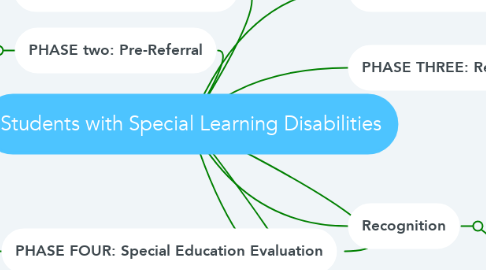Students with Special Learning Disabilities
af Emilie Boivin


1. PHASE two: Pre-Referral
1.1. The pre-referral step in the special education process is formal and meant to identify, develop, and implement alternative education strategies for students who have recognized problems in the classroom before the student is referred to special education. Pre-referral intervention is typically conducted by a Student Centered Team usually consisting of the teacher, the parents/guardians, an administrator, other general education teachers, nurse, guidance counselor, and any other adult involved in the education of the student. The general education teacher provides background information regarding the problem exhibited by the student and the team works together to develop possible solutions (Project IDEAL |http://www.projectidealonline.org/v/special-education-referral-process)
2. PHASE FOUR: Special Education Evaluation
2.1. IDEA requires that students referred for special education services receive a nondiscriminatory multi-factored evaluation.
2.2. The evaluation must be comprehensive and use evaluation tools and strategies that are technically sound and accepted. Most students receive a battery of formal evaluations that measure: Intelligence Achievement Behavioral Disability-specific issues Medical
3. PHASE SIX: IEP Meeting (IEP and LRE)
3.1. The Individualized Education Program (IEP) is a legal contract between the parents and the school district that describes the special education services to be provided by the local education agency which is the local school district. While IEP documents vary, the basic parts of an IEP include:
4. PHASE EIGHT: Reevaluation
4.1. Each year, the IEP team is required to meet for the dual purpose of evaluating the implementation of the current IEP and to develop the next annual IEP. During these annual meetings, the IEP team should discuss the positive and negative elements of the special education services provided and determine, based on any new assessment data, what services should be provided in the upcoming school year.
5. Recognition
5.1. Teachers and school faculty identify significant discreptancies in reading, writing, math, speech or social interaction. This process needs to be backed by evidence
5.1.1. Evidenced must be submitted to the school administration. Parents should be involved.
5.1.1.1. IEP is drawned. Parents should be at all meetings
